#Introduction to Taiwan
Explore tagged Tumblr posts
Text
青白之魅 3: Hair & Makeup Styling
1 Introduction & Presentation // 2 Background & Influences // 3 Hair & Makeup // 4 Set Design // 5 Clothes & Accessories // 6 Conclusion
If you thought there was gonna be less nerd from here on out you are deeply mistaken.
I was responsible for the hair styling for both the white and green snake, which was super fun. I’ve been doing hanfu hair styling for a year or two now (thank you to everyone who let me practice on them!!!) and have gradually gotten better at it, even though I still struggle with some parts of it. I certainly have the equipment collection to show for it now at least! I have so many fake hair pieces I can’t keep track.
As with any hanfu hair styling, the process involved a lot of fake hair, pins, and hairspray—but of course before the actual styling started, which was mostly only on the day of, I had to spend some time thinking about how I wanted the hair to look on each character.

元 衛九鼎 洛神圖, Taiwan National Palace Museum, 她:女性形象與才藝,2020
As far as snake-like hairstyles go, the first thing that comes to mind is the 靈蛇髻/灵蛇髻/ling2 she2 ji4/Spirited Snake hairstyle, shown above on Luoshen, a women’s hairstyle that went through a lot of changes through the dynasties but generally involved a tall, twisting bun leaning slightly to the side on the top of the head, resembling the body of a rearing snake. It’s a very popular style both historically and among hanfu enthusiasts today, because it looks very unique and ethereal. Often, female spirits or goddesses are depicted with this hairstyle.
That was the style I was originally planning on using, but it came with some limitations: one, it’s kind of… in unstable equilibrium? We’d essentially be walking around with the leaning tower of Pisa around on top of our heads. I had to style both of our heads BEFORE setting up the set design, so there was too high of a risk that something would get knocked out of place, since I knew I would have to be running around doing things. Also, because Yulan has brightly colored dyed hair, she had to wear a black base wig under all the fake hair pieces, which is a bit more difficult to pin things to than your actual scalp.
So instead I went with a different design. I knew I still wanted a lot of serpentine loops and strands, and I wanted there to be a significant amount of volume going on—they are ‘spirits’ and ‘goddesses’ after all, they deserve to be fancy!—so I went from there.
The Poetry Vibes
I stumbled upon a few poems last year while looking for names for Cloud9 Hanfu’s Year of the Dragon collection, and a few of them ended up becoming inspirations for this project.
This is the first part of 張可久 (Zhang Kejiu)’s Yuan Dynasty verse, 醉太平·春情 (Drunken Peace · Spring Romance). It’s a bittersweet poem describing a speaker that is longing for a lost love, likening her beauty to the imagery of the evening spring showers outside his home. I’ll do a slightly more faithful line-by-line translation of the poem’s actual words, then a paragraph-form translation with more stylization that gets at the meaning a little more (poetry is really hard to translate).
This is mostly just my interpretation though, and my Classical Chinese is... extremely questionable, so like... take it with a grain of salt.

張可久 Zhang Kejiu, 百度百科
Line-By-Line
烏雲髻鬆,金鳳釵橫。<- “Storm cloud hair is soft and loose, the golden phoenix hairpin is horizontal.”
伯勞飛燕自西東,惱離愁萬種。<- “The shrikes and swallows fly their ways to the West and the East, causing ten thousand kinds of sorrowful goodbyes.”
碧溶溶满溪綠水桃源洞,淡濛濛半窗白月梨雲夢,恨匆匆一簾紅雨杏花風。<- “Jade stream water flows to the Peach Blossom Grotto, moonlight is cast cloudily through the pear blossoms to my half-open window as if through a dream; the wind is unforgiving, felling apricot petals like a red curtain of rain.”
把青春斷送。<- “It ruins the spring.”
Stylized
Storm clouds gather loosely outside my window. I can almost imagine that they are strands of her soft hair; I can almost see where her golden phoenix hairpin would have laid, nestled in her black locks.
It’s springtime now—the orioles should be migrating, flying to their summer homes in the west, and the swallows to the east. Imagining their inevitable parting stirs a complicated sorrow in my chest.
As it storms, clear rainwater collects on the ground in rivulets, streaming away like liquid jade. I wonder where the water is going—is it to some forgotten, untouchable paradise? Is that where she is now? I can see through my half-open window where moonlight drizzles through the petals of the pear-blossom trees, misty and clouded as if I’m dreaming. Suddenly, a curtain of red petals fall across my vision like rain: it’s my flowering apricot tree, struck by the wind.
My trance is broken—spring is over.
//
As Chinese poetry tends to be, it’s very romantic with lots of natural imagery, tinged with sadness. When I reread it with this project in mind, it made me think of Xu Xian after the events of the Legend of the White Snake. While it’s commonly accepted that Bai Suzhen later ends up getting freed and there’s some kind of happy ending, the actual legend itself ends with the White Snake being imprisoned under the Leifeng Pagoda. Many years, if not centuries, pass before she gets out. So as many Chinese romances tend to be, the Legend of the White Snake is, by itself, a great tragedy. I can see the Xu Xian as the speaker of the poem.
Bearing this in mind, I imagine that the beauty of the Snake Spirits are much like the scene described in this poem—soft and ethereal like mist, hiding enough power to bend nature to their will. I decided to lean into the ‘clouds’ theme, especially for Bai Suzhen.

傳 五代 周文矩 仕女圖, Taiwan National Palace Museum, 她:女性形象與才藝,2020 (ft fucked up fat cat)
The comparison of women‘s hairstyles to rainclouds is actually very widespread in Chinese literature, so it was perfect for hairstyle inspiration—in poetry, women are often represented by their features, ex. a poem might say "moth brows" or "cloud hair" to refer to a beautiful lady. Cloud hair and cultivated appearance is integral to the allure of a woman, so much so that the act of putting on makeup can be considered a transformation of identity.
In the linked instance the transformation of identity is supposed to be in the sense of gender identity, but you could also see it (in the context of this project) as the transformation from snakes to women.
This connection is strengthened by another poem, 好事近·夢中作 by 秦觀/Qin Guan from the Song Dynasty.

清宫殿藏画本. 北京: 故宫博物馆出版社. 1994, Wikimedia Commons
Line-By-Line
春路雨添花,花動一山春色。<- “Rain has filled the road with flowers, swaying in the breeze, filling the mountain with the feel of spring.”
行到小溪深處,有黃鸝千百。<- “I walked far along the mountain stream, where there were hundreds and thousands of yellow orioles.”
飛雲當面化龍蛇,夭矯轉空碧。<- “The flying clouds turned into dragons and snakes before me, stretching across the vast jade expanse.”
醉臥古藤陰下,了不知南北。<- “I lay down, drunk in the shade of the vines, not knowing which way is North or South.”
Stylized
I see where the spring showers have filled the mountainside with flowers. They sway in the breeze, bringing with them the rejuvenating scent of spring as I walk deeper and deeper into nature, following the bubbling mountain spring and the crowds of yellow orioles that have come out to celebrate the season as well. As I look up at the sky, I see dragons and snakes form in the midst of the roiling clouds above, leaping and coiling across the expanse of the clear blue sky. Intoxicated, I stop to rest underneath some vines, lost in the beauty of springtime.
//
So I am aware that it kind of sounds like this guy miiiiight be on acid but I'm pretty sure it doesn’t mean he’s hallucinating snakes in the clouds, it’s just like when you look at a cloud and say “that one looks like an elephant!”
Then again there is an interpretation that says his "walking further and further into nature" means he's just getting more and more drunk to escape his problems, so like... make of that what you will. Art is more often than not subjective.
Anyway, dragons also have power over rain and weather, and snakes are often called the ‘little dragon,’ often also associated with flowing water. All this is to say—clouds & coils are good representations of snakes! Also, you’ll notice that both of these poems are about springtime (though the second one is noticeably happier), fitting in with using this project to welcome the Spring Festival :)
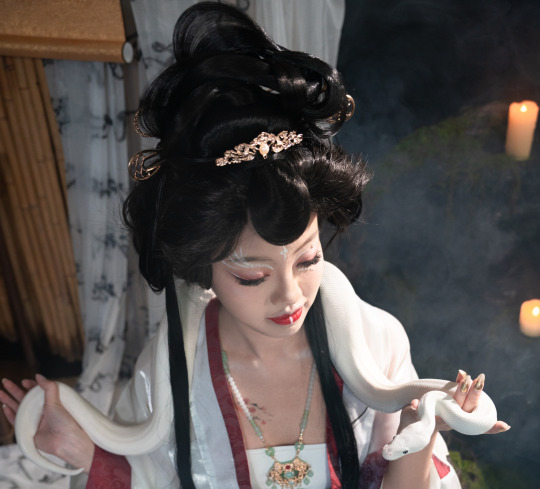
Moving onto individual hairstyles. Keeping in mind the shapes of clouds, I wanted Bai Suzhen’s hair to be very tall, voluminous and ethereal to represent her spiritual prowess and strong will. A bunch of loops fan out at the top center of the hairstyle, adding ‘rays’ pointing outwards like a halo. I made sure there were a lot of round, circular elements to ‘fluff out’ the shape like a cloud. There are two strands of circles kind of peeking out at the bottom behind her neck/ears area, which were achieved by pinning a braid to each side and then pulling the outermost hair strands of each ‘loop’ outwards to create little flat circles.
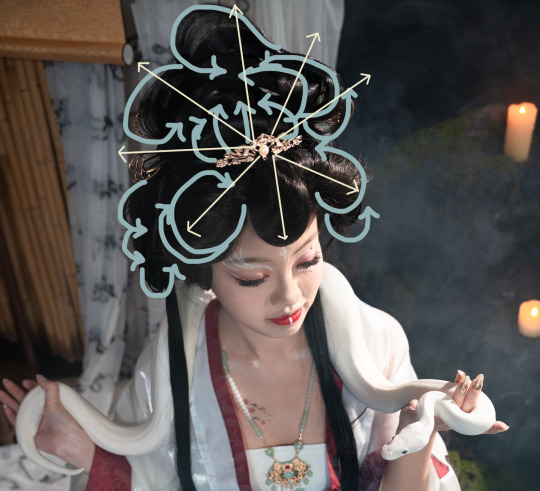
Going back to the first poem, if I imagine that the speaker is Xu Xian thinking of Bai Suzhen, it makes sense for the mentioned ‘gold hairpin’ to appear in her hairstyle, doesn’t it? So I also added a few gold hair accessories—U-shaped pins for the most part, plus a small guan in the center to tie things together—to point outwards above her head.
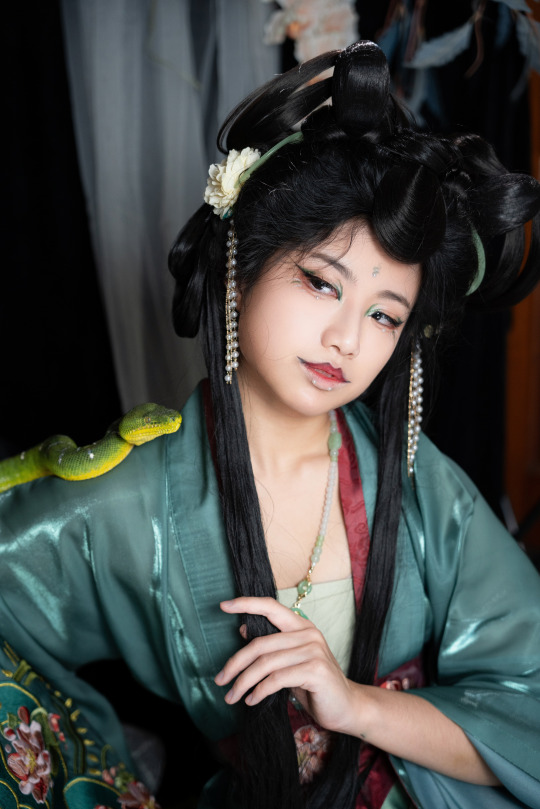
For Xiaoqing's hair, I wanted something that was a little more youthful, but still resplendent enough to do her justice. Xiaoqing is a younger spirit than Bai Suzhen, but still accomplished in her own right. Her hairstyle don’t extend as far outwards as the White Snake’s, but she has two ‘loop’ buns on each side rather than one peak in the middle. It’s kind of evocative of the double bun look often styled on younger girls, but with more fancy loops and swirls added to represent her high spiritual abilities. Each of the two main buns has two strands of hair looping up from the back of the head to the top. The strands are very loose, so depending on how I moved, they separated into several visible strands/just one thicker lock of hair.

The hair accessories I chose for Xiaoqing don’t have as much metal in them, to distinguish her from her sister, as I wanted to emphasize her connection to nature—because she has less experience than Bai Suzhen, she is often portrayed in media (Green Snake 1993 especially) as not yet reaching full human form, still closer to her serpentine origins. She has a white flower with green leaves on each side, standing for spring, youthfulness, and her dedication to the White Snake. There are a couple strands of pearls ‘dripping’ down from the flowers like raindrops, matching with the pearl accessories in the makeup, as well as with the white markings on Dragun’s back.
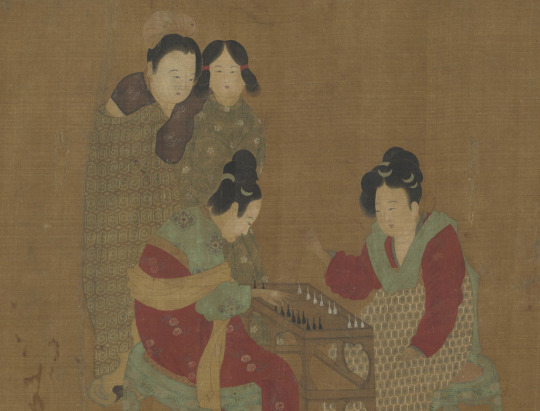
傳 唐 周昉 內人雙陸圖 , Taiwan National Palace Museum, 她:女性形象與才藝,2020
I also chose to include a pair of green half-moon combs, made to imitate jade (they’re acrylic, I’m working on a budget here ;-;). These were often worn several at a time, inserted into different layers of hair (as seen in the image above). Jade accessories are carved from nature—they are often subject to the colorings and properties of the natural base material they are made from, and they are often used to describe natural imagery. This can sometimes be a limitation, but for those who look further it can be an inspiration (see the Jadeite Cabbage, my favorite thing ever, Taiwan Numba One).
Peking Opera Hairstyles
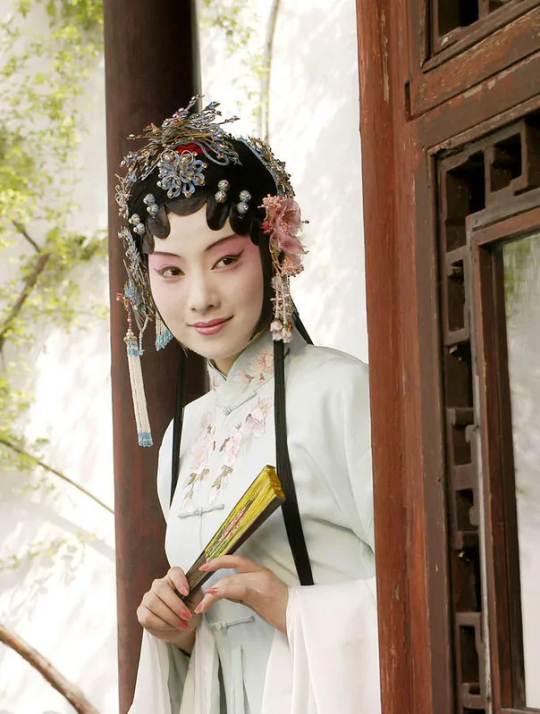
京劇旦角,百度百科
Peking opera influenced the hairstyle design a lot. Dan roles (旦角)in opera have very specific hairstyle protocols. They wear a lot of fake hair pieces and hair accessories just like modern hanfu hairstyles have. One of the base hair silhouettes shared by almost all dan is the traditional 大頭/大头/da4 tou2/'big head,' with most of the hair wound into a large oval bun on the back of the head, and small pieces added at the edges for decoration. To imitate this look, the back of both of the hairstyles are padded with a large, flat, and round hairpiece (known in the hanfu hairstyling community as the 西瓜包/xi1 gua1 bao1/'watermelon bun'). This helps to add volume onto the back of the head, creating the illusion of very long hair that has been neatly wrapped and pinned up.
Another one of the key parts of these hairstyles is the round loop of hair in the center of the forehead. It’s an important feature that I included to tie the two styles together, to make sure it was clear that it was a ‘matched set’ so to speak, and was inspired by the hair loops seen in Chinese Opera styling.

戏曲旦角化妆、梳大头全过程,新浪博客,2011
Traditionally, a solution made from elm tree sap and/or kelp was used as hair gel to glue the little contouring base pieces (貼片子/tie1 pian4 zi0) down to the face. Seven loops called 小灣/小湾/xiao3 wan1/'little curves' line the hairline, one in the center and three off to the sides. I think they look kind of similar to the hairstyle that ballroom dancers have.
This was an artsy hanfu concept shoot, so I didn’t want to necessarily copy the operatic hairstyles—not to mention I don't know how, the motion of making one hair loop alone can take 3-5 years to train—but I did want to include some elements of the opera characters as a nod to their role in popularizing the legend! So each hair design has that central loop. It’s a separate hair piece that I bought for this shoot, whose base I covered with some of the other hair. It isn't glued down like it would be traditionally. I was going to have a few more loops coming down on the sides too, but I found that it looked kind of awkward so I took them off.

There are also two thin strands of hair trailing down each shoulder, another element partially inspired by Chinese opera styling, but it’s very common nowadays to have those there just for the Vibes so it’s not as unique. Most dan roles have a section of long unbound hair trailing down their backs, with two small strands separated out to stream down the front. This is called 線尾/线尾/xian4 yi3/'thread tail' or 線簾/线帘/xian4 lian2/'thread curtain.'
Makeup
Okay so this mostly ended up being about hair rather than makeup because I know a lot more about hair than makeup, but I'll talk a bit about the makeup too lol. I can't speak for the White Snake's makeup—Yulan was in charge of that and she did a marvelous job!—but I did do my own makeup.
The makeup for the green snake came with a great challenge: how do you make my face, arguably the roundest and most nonthreatening thing you’ve ever seen, into something resembling a snake demoness? Also, flamboyant makeup in cool colors can be tricky—too little and it’ll all disappear on camera, too much and it’ll look like a muddy green mess.
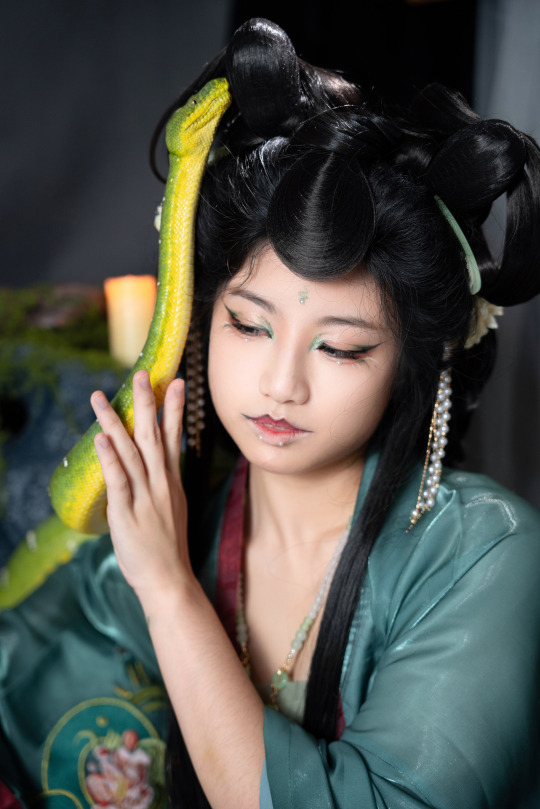
Both my sister and I are fairly warm-toned; green has to be very concentrated in a very small area to look interesting, otherwise it just looks like a bruise (I tried it). So I tried to use a lot of long thin lines of color and angles in the eyeshadow to avoid that, and to kind of draw out the snakey vibes. The meager selection of green eyeshadows that I had weren't the most pigmented, so we made a stop at Sephora (my first time in Sephora believe it or not) on the way from LAX to Riverside and bought some supplies. They turned out to be super super useful.
One of my favorite makeup features was a my sister’s suggestion—fake pearl ‘snake bite’ piercings under the bottom lip! It’s a fun little linguistic easter egg that I’m super happy to have been able to incorporate into her styling.

宋人 宋高宗后坐像,Taiwan National Palace Museum, 她:女性形象與才藝,2020 Look closely and you'll see dozens of tiny women depicted in pointillism on her guan headdress!
Pearl makeup (珍珠花鈿/珍珠花钿/zhen1 zhu1 hua1 dian4)was really popular throughout several dynasties, but especially the Song Dynasty, where it became a huge trend among nobles. Today it mostly appears in hanfu circles, but I believe some Southern Chinese opera styles use them too.
As far as I know, the position that we put them in under the bottom lip is anachronistic, but they did often appear at the corners of the mouth/the dimples (面靨/面靥/mian4 ye4), so if you stretched it a little and imagine they've just been moved slightly, I could probably claim that it's at least historically inspired.

元人 畫梅花仕女, Taiwan National Palace Museum, 她:女性形象與才藝,2020
Other places that pearl makeup often appeared was on the temples, cheeks, or forehead. I also put a pair under my eyes just for funsies (I find that using smaller-sized pearls looks better to me, even though the ones shown in paintings are usually fairly large).
//
Okay that ended up being a lot longer than I thought it would be. I am so tired wow. The next one might take a while to come out too, but hope this one was enjoyable :)
1 Introduction & Presentation // 2 Background & Influences // 3 Hair & Makeup // 4 Set Design // 5 Clothes & Accessories // 6 Conclusion
#hanfu#hanyuansu#chinese hanfu#chinese fashion#chinese history#hanfu fashion#hanfu photoshoot#hanfu art#long post#like really really long post#hanfu makeup#makeup#chinese makeup#hanfu hairstyle#hanfu hair#青白之魅#cloud9 hanfu#cloud9hanfu#九雲閣#snake#snakes#洛神#chinese opera#peking opera
83 notes
·
View notes
Text
XLOV Basic Introduction!
XLOV is a 4-member K-Pop boy group under 257 Entertainment. They officially debuted on January 7, 2025 with their first single "I'mma Be". They have a genderless concept, and day of their debut showed love and support for the lgbtq+ community during fancalls.
(The members do not have official positions but I added my own based on what they did for their debut)
The heart emojis are their representative colors that Wumuti gave them.

•
•Wúmùtí Tǔěrxùn / Wumuti (우무티) 🐰/❤
•Born in Ürum, Xinjiang, China on July 7th, 1999, He’s ethnically Uyghur.
•Height: 175cm (5'9)
•Leader, Vocalist, Dancer, Producer, Songwriter.
•He is a former member of the C-pop group SWIN. He debuted in the project group WATERFIRE. He has been a contestant on several South Korean survival shows, Boys Planet, Under Nineteen and Build Up: Vocal Boy Group Survivor. He made his solo debut in 2024. He was a trainee for over 6 years. As he had a big following before debuting he's the only member with a public Instagram, it's now only being used for promotions. Wumuti formed the group himself.

•
•Chen Kuan Jui / Rui (루이) 🦋/🩷
•Born in Taipei, Taiwan on December 28th, 2000.
•Height: 175cm (5'9)
•Vocalist, Dancer.
•He is a former YueHua Entertainment trainee. He trained for over a year before becoming a contestant on Boys Planet.

•
•Kim Jin Hyung / Hyun (현) 🐵/💙
•Born in South Korea on July 26, 2002.
•Height: 185cm (6'1)
•Vocalist, Dancer.
•He was a trainee for 5 years. He is the only member who has no survival show experience. He kinda showed up out of nowhere hence why there's very little information about him.

•
•Kato Haru / Haru (하루) 🦊/💛
•Born in Hyogo, Japan on February 18th, 2006.
•Height: 168cm (5'6)
•Vocalist, Rapper, Dancer, Maknae.
•He was a contestant on Boys Planet. He used to be a member of the K-pop dance cover group KIS KPOP.

With some moments of theirs already going viral (Rui having a fancam on twitter of him dancing with over 2M views) I can only hope for the absolute best for these boys! They've worked so hard for many years to get here and to finally debut. I will support them the whole way and I hope you do too!
#xlov#xlov wumuti#xlov rui#xlov hyun#xlov haru#kpop#kpop bg#lgbtq#genderless#boys planet#chen kuanjui
83 notes
·
View notes
Text
First Note of Love hooked me instantly. I’m so excited to get another high quality Taiwanese bl this year. Core premise:
Neil and his brother Matt were a famous music duo until Matt died in an accident. Neil has been deep in grief, a general wreck, and unable to perform or make music since. He has to produce an album this year or his contract terms will be violated, losing him both his source of income as well as the copyright to the music he made with his brother. His manager recruits a hot young composer, Sea, to work with him on the album, who has his own connection to Neil from the past.
I love this premise and the show feels really solid. The character introductions were great and we already got a chance encounter, a childhood connection, and an accidental kiss by the first episode (this is Taiwan, after all, the tropes will be plentiful but they’re using them well). This is a GagaOOLala original so that’s where you can find it along with Viki. The first two eps are already up!
ETA: @pharawee reminded me this show is co-produced by Thailand’s Star Hunter and one of the cast members is Thai. I’m so intrigued by these cross-country collabs we’ve been getting.
85 notes
·
View notes
Text
Dassault Mirage 2000
The Mirage 2000 is a multirole combat aircraft developed by the French company Dassault Aviation. It is known for its delta-wing design and has been used by numerous air forces worldwide since its introduction in the late 20th century.
The Mirage 2000 has been widely exported, with operators including India, France, Egypt, Greece, Taiwan, and Brazil, among others. It has proven itself in combat, notably during conflicts such as the Kargil War (India-Pakistan conflict) and other regional skirmishes.

40 notes
·
View notes
Text
Alright, sound off! WHO is learning Classical Chinese?
I want to find friends to study with and complain to!!!
I have gotten back into it in a more serious capacity after a few years of nonsense, and am continuing (sigh) to work my way through Introduction to Literary Chinese by Michael A. Fuller.
Please reblog for greater sample size! Beginners or 古文大师 all please reply!
I know some people in HK, Singapore, Malaysia, Taiwan, China, greater Sinosphere/diaspora might be also doing it or have done it as a school subject, and I'd love to hear from you guys too :D
#classical chinese#literary chinese#chinese langblr#learning chinese#language learning#>>>I only ever tag so assiduously when I REALLY want an answer so everyone else#please support my quest by gifting me with lembas bread and/or cloaks of elven craft (i.e. reblogging)
28 notes
·
View notes
Text
(Absolutely Not) Mircro (Mostly) BL Reviews
I really should find a new title for this. So often none of these are micro nor are they all BL. But I am lazy and bad at titles in general, so it will stay this way forevermore.
With that riveting introduction out of the way, let's just get started, yes?
In no particular order.
Completed
The Loyal Pin (Thai, GL): Enjoyed this one a lot for most of it. I had a great time just looking at it, everyone and everything was so pretty. I swear the show lingered on Freen and Becky's gorgeous faces abnormally long always just to highlight how gorgeous they both are. This is not a not a complaint. The acting was on point, as always, especially Freen who I just loved as Pin. And I loved seeing Becky playing the pursuer and the one who was a bit of a spoiled brat. The plot did get a little meandering here and there - I am not complaining about the length because I would have watched 80 more episodes but it did drag on occasion, and some of the cuts were a little odd. Anin especially seemed to have teleporting powers on occasion. One thing I really did like although it made me furious was how it mostly realistically engaged with the real struggles that Anin and Pin would have to go through to be together. I was furious at Pat more than once for ignoring things that were right in front of her face that spelled out what a shit Kuea actually was and just ignoring it, but the reality of Pin having to marry a man she did not love felt very realistic, especially considering her station relative to Anin's. Not sorry that they went the happy route in the end but I did like that Pin's struggles were real. Kuea was an impressive dick. That guy is really good at sucking, kudos to him. My one real quibble (and what dragged this down an entire point in the end) is the "joke" the king played on Pin when she was removed to her forever house with Anin. I'm not against messing with people but they literally ripped her out of a sobbing Pat's arms, blindfolded and driven off to who knows where. The poor girl was terrified and call me humourless but I didn't find it funny in the least. Not with everything else she'd been through. So final verdict is 8/10.
Kidnap (Thai, BL): This one I actually stopped watching about halfway through and then just binged when it was over. It was okay. I didn't have the ton of criticisms others had, but it also really wasn't my favorite, either. It was a turn your brain off and watch the pretty kind of show, I genuinely do not believe that it ever aspired to much higher than that, and I think that as a show like that it served its purpose. To be honest, unless the show was completely unwatchable I'd have finished it simply because the people losing their tiny minds over the fact that Ohm was paired with someone other than Nanon annoyed the everloving fuck out of me. I am not one who is hugely bothered by branded pairs working together over and over but if I was, the reaction to this would have been a great point in its favor (another is the way far too many "fans" of branded fairs treat the less popular or less liked one, but that's also just people being dicks and would probably happen anyway - it's just having to see the same person get it over and over that is rough). Aside over, the show was fine. It didn't do anything revolutionary but I don't really think it was trying to. Ohm was great as always, other Ohm was a great as the little bro, Leng was fine (he's green and it shows, especially when he has to do some of the more emotional scenes, but he's not bad. And I think he did Q's panic attacks and PTSD related trauma very well indeed). All in all, it was your standard romcom fare. Easy to watch, and easy to forget when it was over. 7/10.
Unknown (Taiwan, BL): Adopted brother trop baby. Don't look at me I don't care I eat it up. I love me a good stepbrothers / adopted brothers who fall in love tale, and so does Taiwan. I had a good time with this one. All episodes were out so I binged it all via Viki which is honestly how I like to do it with shows like this - I just don't have the energy or the mental strength to wait on tenterhooks for another episode when I get super invested and things aren't going well (Jack & Joker nearly broke me and THK kind of puts me in a frothing rage - more on this later maybe), plus it helps when I can consume this type of stuff all on my own. Stuff that I imagine people have Opinions about. Opinions that will probably annoy me. It's why to this day I'm still glad I watched most of MLC in a vacuum and wasn't watching live until the final eps. I just know the opinions on that one would have send me 'round the bend. But this isn't about those shows, it's about Unkwon. I quite enjoyed it! I liked that everyone was kind of a mess, pretty much exactly as you would expect them to be, considering. No one here has their shit together, especially not the one who seems to have it the most handled. I also really liked all the pining and yearning. If you know me at all you know that I am the biggest fan of reverse pining and this show delivered that to me in spades. I could have watched thirteen episodes of Wei Qian missing Xiao Yuan so badly he could taste it. Chemistry was also on point, but honestly Taiwan almost always delivers there, I might worry about the story but I never worry about the chemistry. 8/10.
Night Has Come (Korea, gen): This one absolutely had me hooked pretty much from the beginning, and I loved it so much for pretty much the entirety of the drama. The cast is excellent, I was infuriated, I cried, I sat on the edge of my seat wondering what was coming next...and then the end kind of annoyed me and made the story fall apart just a little. Not enough to kill my enjoyment, but enough to drag my overall score down to 7/10. Would still recommend it though, if only for the ride. But man, one thing Kdramas are very good at it making me furious at the characters. Weak Hero Class 1, The Glory, All of Us Are Dead, Squid Game...just to name a few. All of these had me incandescent with rage at some point or another. Kudos?
Peaceful Property (Thai, gen or "bromance"): Oh my gosh this show. I knew I'd like it, but I did not expect to love it quite as much as I did. Home was such a delightful character. Peach, Pang, and Kan (my girl!) were great too, but for me Home is what made the show. He was a little naive and far too unaware of his own privilege, but one thing I loved about him is that he was never cruel or even that greedy. He was a little (a lot) useless in the beginning, but through meeting Peach and Pang and Kan he learned to be less so, and also finally found a place where he could belong - something he was looking for for the entirety of the show. Family. This show did the found family thing so well without making it too treacly, which I loved. These four people needed came into each other's lives, each of them having what the others desperately needed, and I love that for them. This show just had so much heart. I don't know how else to say it. I loved it so much. 9/10
Jack & Joker: U Steal My Heart IThai, BL): Oh, this show. So I only recently watched Love Mechanics for the first time this year, and I had no clue about YinWar until then. I know, right? But hey, I watched it right in time to actually get jazzed for this show. I love that we had two different shows airing about mafia-esque at the same time that took very different tracks. While Kidnap went the more romcom slapstick route, Jack & Joker did engage a bit with the darker side of it. Literally everyone at the top sucked, but Boss was the worst of them all. And the worst part about him was that he convinced himself that he was doing it for great justice. I was amused, though, because Mark was my darling baby who could do no wrong in Love Mechanics but in J & J it was absolutely Jack. I loved Joke too but Jack was my darling boy who was so sweet and hopeful and that just kept getting kicked down by life every time he came close to finding a way out. I felt for that man so much. My one criticism is that I didn't love the end. Everything felt a little too pat and perfect after what had happened. But it's not that big of a complaint. I don't think I would have loved a bleak ending either. So many of the side characters helped make this one - I loved Tattoo, Aran and Hoy, Hope and Save grew on me, and Nang was gorgeous even if sometimes the things she did made me want to scream. Grandma was the best and Toi Ting was a delight and stole nearly every scene she was in. Love that little girl. So often with shows I find myself just wanting the main characters to get back on screen but with J&J I felt like that way less. Also, I didn't even mind the long run time of the eps. One last thing I will say is that I really did wind up enjoying the character of Rose. I know that she was rough for some people - it can be very hard to like someone that has no clue about their own privilege or how their wealth has opened doors for them that are impossible for other people to open, or how the people around her played with the lives of others like it was no big deal - but I do think that her slow realization about it was pretty well done. She may have started out extremely naive but by the end her eyes have been opened and she's committed to making some real changes. I like to think she succeeds - girl's tenacious. Also, even if I hadn't liked her already, the way she reacted to being rejected by Jack would have made me like her. It was classy. 8/10
I went on for so long about High School Frenemy that I eventually gave up and gave it it's own post. Do what you will that that one.
Currently Watching
The Heart Killers (Thai, BL): Came mostly for FK, am staying entirely for JD. This is absolutely going to be one of the shows where it's best if I just watch in a vacuum, I think. Especially because I'm more than a little bitter and it's going to get worse rather than better, if I'm right (and I almost always am It's a curse). I do think that we can all agree that Fadel deserves the world, though.
Spare Me Your Mercy (Thai, BL): I am in love with this show. There is so much going on here and every week I'm excited to watch but also not wanting it to be over. Tor and JJ are doing so well and I like that it's making me think. Dr. Kan has never done a thing wrong in his life and I will fight people for him. I also kind of love that neither he nor Wasan are both playing a game and are still managing to fall into the trap anyway, both their own and each other's. Just a great show. Also has me wanting to watch Manner of Death so I will be starting that shortly.
Petrichor (Thai, GL): it's a procedural but everyone's a lesbian. I love it. And everyone is so hot. Like I can barely focus on what they're saying half the time my god. I'm really having a good time with this one.
Pluto (Thai, GL): This show is so fucking good. Namtan is so amazing - I love how different Oom and Ai are, even when they are making the same expressions the way they carry themselves is so opposite you always know who you're dealing with. Film is also doing great as May - a delicious mix of vulnerability and strength, uprightness and manipulation. Also my gosh I keep getting slapped in the face with how ridiculously pretty she is like very five seconds. Did NOT expect the memory loss curveball but I am here for it. Also if the PimJanPang triangle doesn't end in a throuple I might actually cry, but if they all make out with each other a little I will forgive the show if it doesn't end with them all together.
ThamePo (Thai, BL): still not committed but I enjoyed the first episode. Someone should have told me Ciize was in it and I'd have been there with bells on anyway. I love her. So far though it's not like what I thought based on the mock trailer, so I'm cautiously into it.
Looking Forward To
Ossan's Love Thailand: we'll see on the comedy. Sometimes it hits. Sometimes it does not. The more slapstick stuff is iffy for me but I do love EM so.
The Boy Next World: oh my god this looks like exactly my thing. I can't wait.
My Golden Blood: No trailer but I don't even care. GIMME already it's been 84 years.
#the loyal pin#kidnap the series#unknown the series#night has come#jack and joker#peaceful property#the heart killers#spare me your mercy#petrichor the series#pluto the series#thamepo#heart skips a beat#ossan's love th#the boy next world#my golden blood#micro reviews#rambles
25 notes
·
View notes
Text
The real life inspirations behind new characters in Touhou 19 (Unfinished Dream of All Living Ghost) While I haven’t been posting much about Touhou as of late, I felt obliged to put together the customary post about the inspirations behind the new characters. The new game genuinely renewed my interest. In contrast with similar write-ups pertaining to previous games the research is not entirely mine - some of the sections are a result of cooperation between me and @just9art. Without further ado, let’s delve into the secrets of the new cast. Find out if Biten is the first “Wukong impersonator” ever, when a tanuki is actually a badger, and why Hisami both is and isn’t an oni. Naturally, the post is full of spoilers. Also, fair warning, it's long.
1. Biten Son - sarugami + Sun Wukong

Sarugami means “monkey kami”, the monkey in mention being the Japanese macaque.To my best knowledge, the term is actually not used commonly in English - the results on jstor and De Gruyter are in the low single digits, Brill outright has nothing to offer. Translations are much more common.
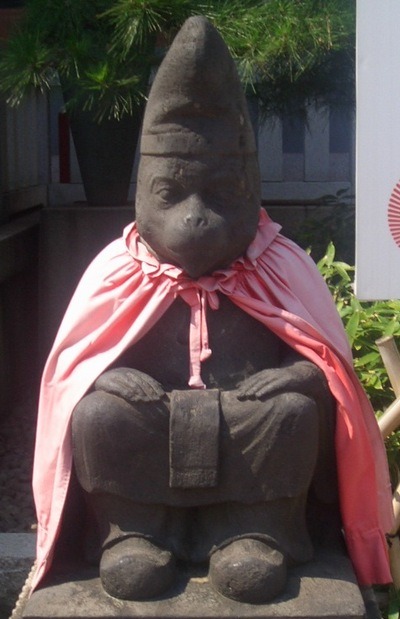
Sarugami are particularly strongly associated with Mount Hiei. You might have heard of it because of its association with Matarajin, though in this case he’s not exactly relevant. Instead, it is believed the monkeys act as messengers of Sanno (the “mountain king”), Sekizan Myojin and Juzenji. Sanno himself could take the form of a monkey according to medieval texts, while Juzenji can be accompanied by a deity depicted as a man with a monkey’s head, Daigyoji, known from the Hie mandala. Sarutahiko is also associated with monkeys based on the similarity between his name and the word saru. Bernard Faure notes that despite the clearly positive portrayal of monkeys as semi-divine beings in service of these deities, their perception in folklore and mythology can nonetheless be considered ambivalent, because they could be viewed as aggressive. There are even examples of sarugami being portrayed as monstrous antagonists to be defeated by a hero. The best known tale of this variety is known simply as Sarugami taiji. It is preserved in the Konjaku monogatari. Here the sarugami is a fearsome monster who terrorizes a village and demands the offering of one young woman each year.
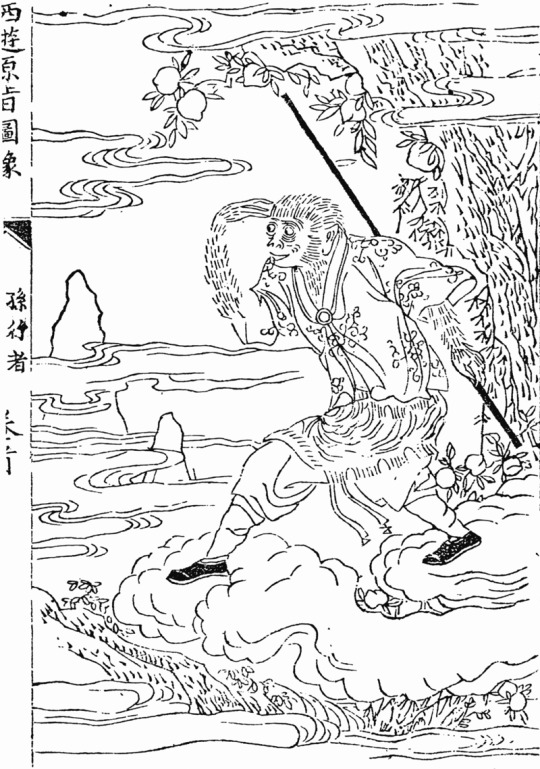
In contrast with the sarugami, I do not think Sun Wukong, one of the protagonists of the classic Chinese novel Journey to the West, needs much of an introduction. We reached the point where even in the west he is recognizable enough to warrant toys based on him (there’s a Lego Wukong on my desk right now). Biten's design has many callbacks to traditional portrayals of Wukong, including the staff (which in the novel is a pillar stolen from the undersea palace of a dragon emperor) and a very distinctive diadem (in the novel making it possible to pressure the unruly Wukong into obeying the monk he is meant to protect). As a curiosity it’s worth noting that “fake Wukong” is not a brand new idea - in the novel itself, one of the enemies of the heroes, Six-Eared Macaque, actually impersonates him for a time. Wukong is effectively himself a “divine monkey”, seeing as despite his origin as a literary character he actually came to be worshiped as a deity in mainland China, Taiwan and various areas with a large Chinese diaspora. The topic of Wukong worship itself came to be an inspiration for literature, starting with the excellent The Great Sage, Heaven’s Equal by Pu Songling, a writer active during the reign of the Qing dynasty, in the early eighteenth century.
2. Enoko Mitsugashira - “immortal yamainu” + Cerberus
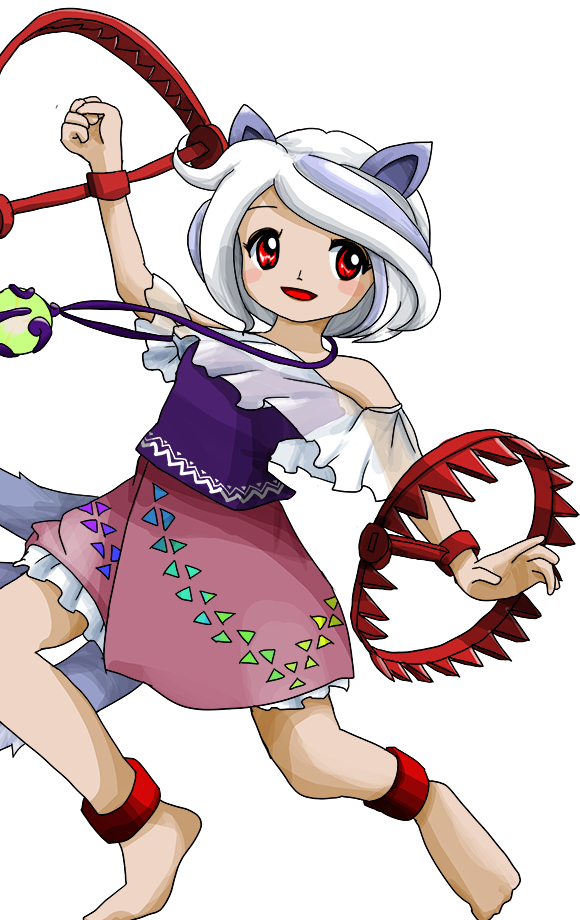
Enoko gets the least coverage here, because there really isn’t much to say. Yamainu, “mountain dog”, isn’t really a supernatural creature, it’s an old term for either the extinct Japanese wolf, a type of feral dog, or a hybrid between these. It can also be used as a synonym of okuri-inu, a youkai wolf believed to accompany travelers at night.

There’s actually a distinctly Journey to the West-esque component to Enoko’s backstory, but I have no clue if this is intentional. In the aforementioned novel, many of the antagonists, who are generally demonic animals, are motivated by the desire to devour the flesh of the protagonist, the Buddhist monk Tang Sanzang, because it is said to grant immortality. Granted, given the obscurity of the figure Zanmu is based on - more on that later - perhaps this is an allusion to something else we have yet to uncover. Cerberus, being probably one of the most famous mythical monsters in the world, does not really need to be discussed here. The illustration is included mostly because I like Edmund Dulac and any opportunity is suitable for sharing his illustrations. I do not think it needs to be pointed out that Enoko's bear trap weapons are meant to evoke Cerberus' extra heads.
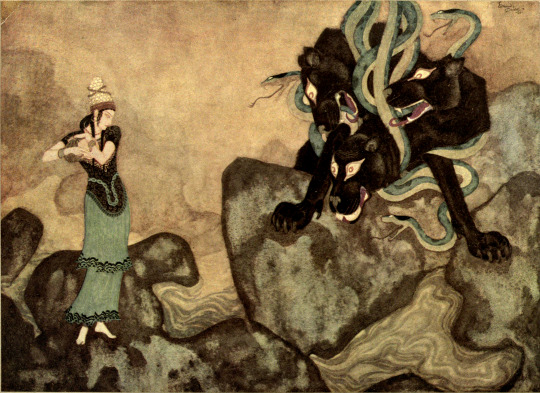
3. Chiyari Tenkajin - tenkaijin (+ mujina) + chupacabra
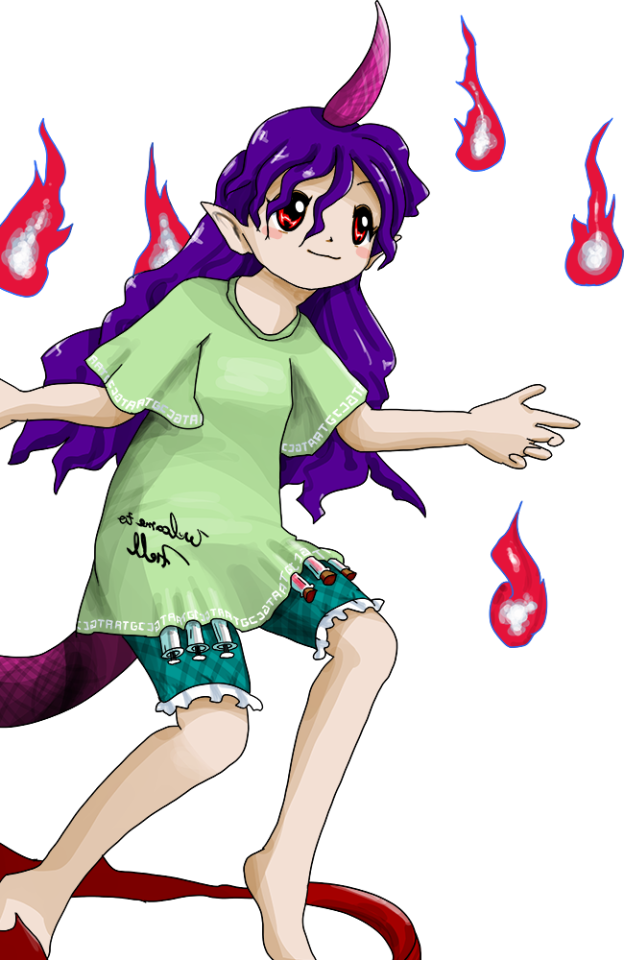
While my favorite animal youkai not yet featured in Touhou is easily the kawauso (otter), I was very pleased to learn we sort of got a mujina since I wanted to cover this topic since forever, but never got much of a chance. Technically Chiyari is actually meant to be a tenkaijin, which is not a mujina but a slightly different youkai (a will-o-wisp or St. Elmo’s fire-like creature, specifically) who in the single tale dealing with it takes the form of a mujina after dying, but as there is not much to say about it beyond that you will get a crash course in mujina folklore instead.

Today the word mujina is pretty firmly a synonym of anaguma - in other words, the Japanese badger. The animal does not substantially differ from other badgers, so I do not think much needs to be said about its ecology. However, historically the term could be used to refer to the tanuki regionally, or interchangeably to both animals, so in some cases if insufficient detail is provided it is hard to tell which one is meant. This ambiguity extends to the folklore surrounding them, and generally if you know what to expect from tanuki tales, which I’m sure most people reading this do, you will instantly recognize many of the plot elements typical for mujina ones. In other words, it is yet another yokai which typically takes the role of a shapeshifting trickster. Some supernatural phenomena could be basically interchangeably attributed to mujina, tanuki, kitsune or kawauso. Mujina are commonly described taking the form of Buddhist monks, which is one of the many similarities between them and tanuki.
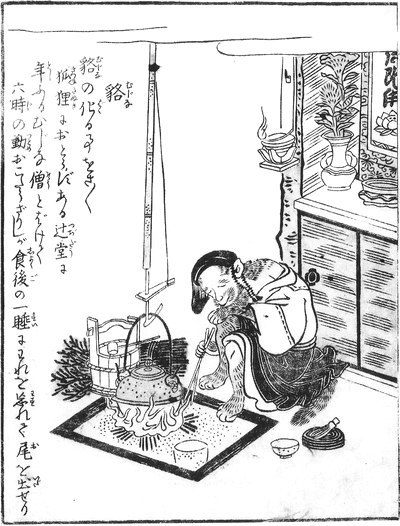
The most famous depiction of a shapeshifting mujina comes from Toriyama Sekien’s Konjaku Gazu Zoku Hyakki (The Illustrated One Hundred Demons from the Present and the Past). The accompanying text compares the creature to the supernatural versions of kitsune and tanuki, and states that the artist relied on a tale according to which a mujina was able to successfully impersonate a Buddhist monk until accidentally revealing its tail.
What makes the mujina special is that it is actually the oldest recorded example of a youkai of this sort. A mujina tale already appears in the early Japanese chronicle Nihon Shoki, dated to 627. It reports an incident of a mujina transforming into a human and singing somewhere in the Michinoku Province. I feel like this alone is a good example of why you should be wary of people who seek to present Nihon Shoki or Kojiki as historical truth. Western audiences as far as I know were first introduced to mujina by Lafcadio Hearn. To my best knowledge, the fabulous shapeshifting badgers however failed to gain the popcultural recognition enjoyed by tanuki and kitsune. They did appear in Shigeru Mizuki's stories every now and then, and I found a mascot character based on them, but overall there isn't all that much beyond that.
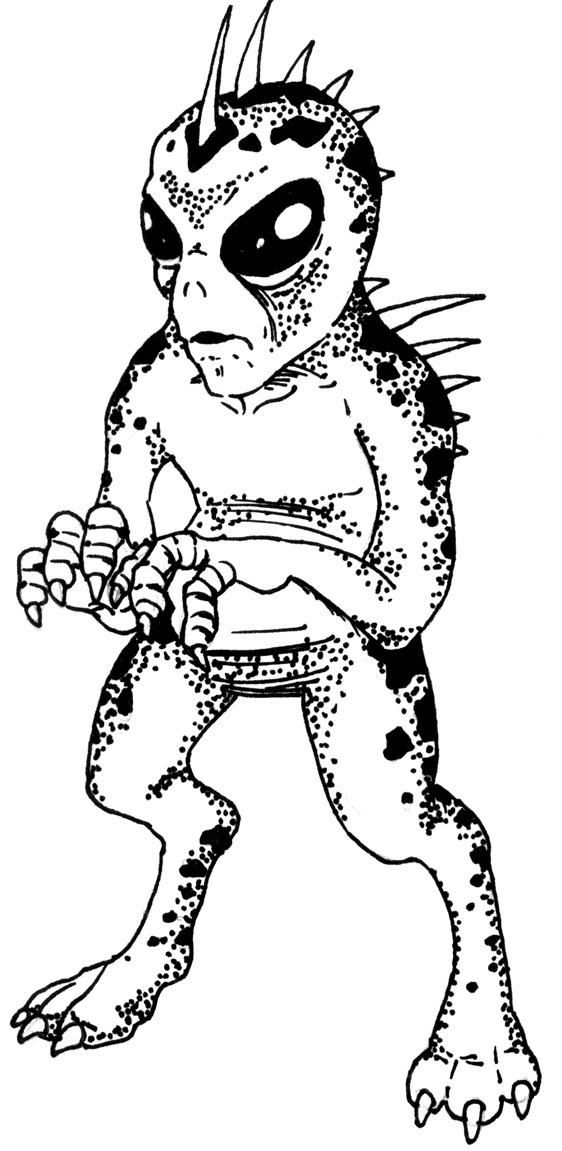
Naturally, there isn't much mujina in Chiyari's design, and she instead most likely owes her distinctly spiky appearance to the other inspiration behind her character, the chupacabra. Mujina are not really portrayed as bloodthirsty, but the poorly documented tenkajin apparently is, which is presumably why ZUN decided to connect Chiyari with the chupacabra, the best known modern blood-drinking creature, who first appeared in tall tales from 1995 and subsequently took popculture by storm after spreading from Puerto Rico to mainland USA and Mexico. I am not a chupacabra aficionado so I have little to offer here, sadly.
4. Hisami Yomotsu - yomotsu-shikome
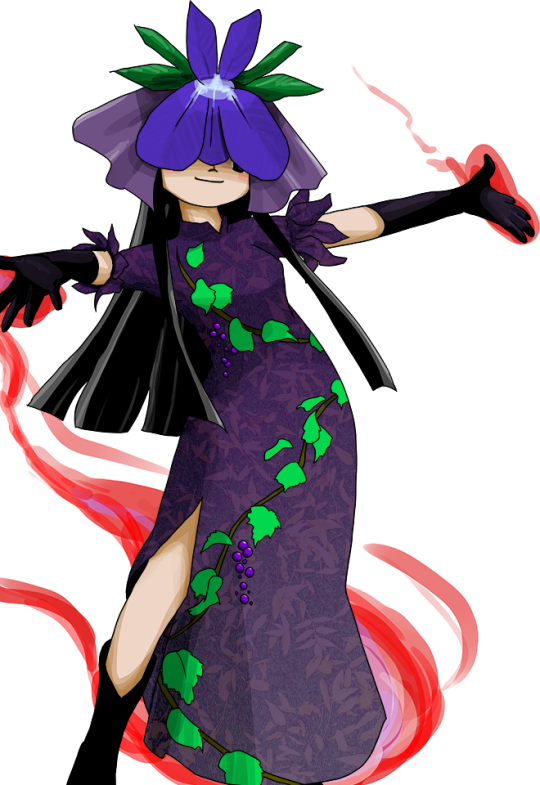
Judging from what I’ve seen on social media and on pixiv, Hisami is shaping up to be one of the most popular new characters (she’s my fave too). In sharp contrast with that, her basis is pretty obscure. So obscure that there isn’t even any historical art to showcase, as far as I can tell (note that this blog claims night parade scrolls might have something to offer, though - I was unable to verify this claim for now, sadly). As we learn from her bio, she is supposed to be a yomotsu-shikome. They’re called the “hags of Yomi” of Yomi in Donald L. Philippi’s Kojiki translation. The term shikome can be literally translated as “ugly woman”. Nothing about them really implies femme fatale leanings we are evidently seeing in Touhou but I’m not going to complain about that. Yomotsu-shikome appear only in the Kojiki and the Nihon Shoki, and in both of these early chronicles they are portrayed as servants of Izanami after she died and came to reside in Yomi, the land of the dead. Nihon Shoki states there are only eight of them. The distinct grape vine motif present on Hisami’s clothes seems like an obvious reference to Izanagi’s escape from Yomi following his meeting with Izanami, portrayed in the myth recorded in both of these sources. When the yomotsu-shikome started to pursue him, he threw a vine he used to hold his hair at them. The plant instantly bore fruit, which the entities started to eat. They later resumed the chase, but were once again held back, this time by a bamboo shot. According to the Nihon Shoki, they eventually give up after he creates a river from his piss (sic) to keep them away.
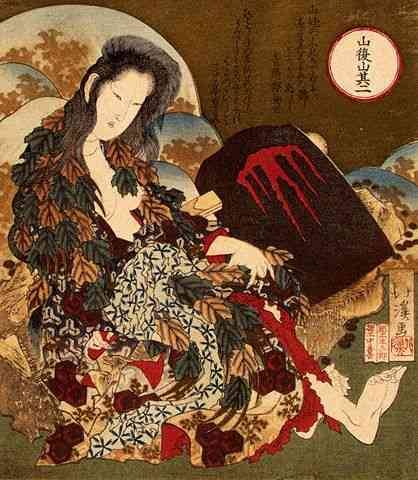
Yomotsu-shikome are sometimes compared to oni by modern researchers. Noriko T. Reider in her monograph about oni argues that alongside hashihime and yamanba (pictured above) they can be effectively grouped with them. Another researcher, Michael D. Foster, is more cautious, and states that despite clear similarities it’s best to avoid conflating oni-like female demons with female oni proper, especially since the latter have a distinct iconography and a distinct set of traits. Norinaga Motoori, the founder of kokugaku or “national learning”, a nationalist intellectual movement in Edo and Meiji period Japan, claimed that oni were based on yomotsu-shikome, which is a pretty dubious claim. It is ultimately not certain when the term oni started to be used, but it is safe to say it has continental origin. And, of course, oni permeate Japanese culture in a way yomotsu-shikome do not.
5. Zanmu Nippaku - Zanmu

This was the toughest mystery to solve, and I am fully indebted to 9 here, since they figured it out, I am merely depending on what they directed me to. Research is still ongoing, and it feels like we just started to untangle this mystery, so you can safely expect further updates. Zanmu appears to be based on the Buddhist monk… well, Zanmu. You can learn a bit about him here or on Japanese wikipedia; it seems there are quite literally 0 sources pertaining to him in English, and even in Japanese there is actually very little. Their names are not written the same, ZUN swapped the sign for “dream” from the original name for one which can be read as “nothingness”. If the unsourced quote on wikipedia is genuine, the reason might be tied to the personal views of the irl Zanmu. What little we’ve been able to gather about him is that he was active in the Sengoku period, and apparently was regarded as unorthodox and eccentric. This lines up with Zanmu’s omake bio pretty well. Seems the real Zanmu was also unusually long lived, and was able to recall events from distant past in great detail, though obviously the figure of 139 years attributed to him in a few places online has to be an exaggeration.
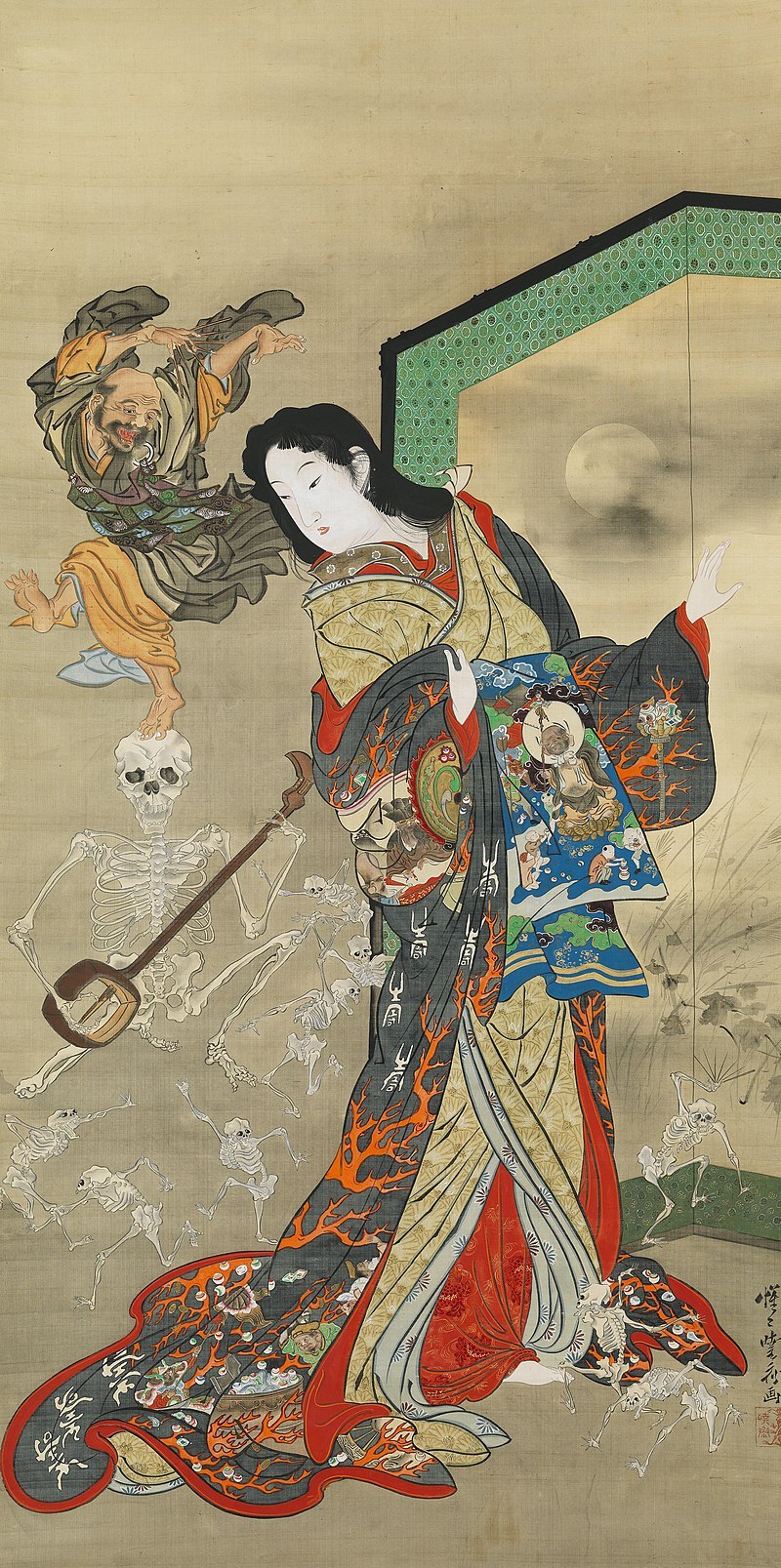
Yet more puzzling is the reference to Zanmu’s familiarity with Ikkyo you might spot in the linked article. Whether the famous Ikkyo who you may know from the tale of Jigoku Dayu is meant is difficult to determine. The chronology does not really add up; on the other hand the logic behind associating one eccentric semi-legendary monk with another in later legends isn’t particularly convoluted. As 9 pointed out to me, if ZUN was aware of this link, and the same Ikkyo really was meant, it is not impossible the connection between Zanmu and Hisami is meant to in some way mirror that between Ikkyo and Jigoku Dayu. As you can easily notice, it’s pretty clear the historical Zanmu was male. It does not seem his Touhou counterpart is, obviously. I would say we should wait for more info until declaring that we have a second Miko situation on our hands, with a male historical figure directly reimagined as a female character without any indication we are dealing with a relative rather than the real deal. There’s still relatively little info to go by so I would remain cautious (though naturally this is not meant to discourage you from having headcanons).
Neither me nor 9 were able to find any connection between the historical Zanmu and oni… so far, at least. Therefore, what motivated ZUN to make Zanmu an oni remains to be discovered. As a final curiosity, on a semi-related note it might be worth pointing out that while not as common as their male peers, female oni are not a modern invention, and already appear in setsuwa from the 13th century. A particularly common motif are tales describing a woman turning into oni due to jealousy or anger. Further reading:
Jason Colavito, The Secret Prehistory of El Chupacabra (2011)
Bernard Faure, Gods of Medieval Japan vol. 1-3 (2015-2022)
Michael Daniel Foster, The Book of Yokai. Mysterious Creatures of Japanese Folklore (2015)
John Knight, Waiting for Wolves in Japan. An Anthropological Study of People-wildlife Relations (2003)
Noriko T. Reider, Japanese Demon Lore (2010)
279 notes
·
View notes
Text
2024 Roundup - BL edition
It's done!! I spent WAY too long on this post and I have no idea why, but I've done it now haha
2024 was the year I started watching live action BL series (I went over how I got here a bit in this post, so I won't go over it again; I also reflected a little on how nice it's been to watch all these shows), so my focus wasn't on watching what's new (everything was new to me) but mostly playing catch up. That said, I did watch enough 2024 releases to let me do a top ten, so why not?
In all honesty, I'm a little embarrassed to be posting this. Like I said, I only started this year, so I'm not really sure my top shows of the year are particularly valuable or interesting to anyone but me, but I do love me a list! And I spent all this time on this post, so, here we go?

First, some numbers:
I watched around 25 or so 2024 releases (some spanned 2023 and 2024, but I don't feel like double checking all the 2023 releases I've logged on MDL to check when they started and finished). Of those 14 are Thai, 4 are South Korean, 5 are Japanese, 1 is Taiwanese, and one (Meet You at the Blossom) is a Thailand/Taiwan co-production iirc
My ratings ranged from 7.5 to 10, but honestly there was nothing I hated. Some I felt 'meh' about (which I won't talk about here) but even those had aspects I thought were really good. Maybe I'm just easy to please, but I'm happy. Anyway. Onto the list!
More details under the cut (with possible spoilers, but it's most personal reflection rather than any kind of analysis), but if you want just the list:
Cherry Magic Thailand
Wandee Goodday
Century of Love
Kidnap
Happy of the End
Monster Next Door
Love for Love's Sake
Boys Be Brave!
Love is a Poison
We Are
CHERRY MAGIC (THAILAND)

(This spanned 2023 and 2024, so I'm counting it!) Image from BL Watcher, edited by me
This is such a special show! Being new to BL this year, I watched this not long after I watched the Japanese live action version, and I was kind of worried it might suffer for it, but I loved it just as much. They both had aspects I liked better than the other, but I love this show so much. I've watched it three times now I think? It was my introduction to Tay and New and I fell head over heels for them haha
I really enjoy the friendships in this, but, as I'm here for the romance, I have to say Achi and Karan's love is one of the sweetest and swooniest romances I've seen maybe ever! That beach scene lives rent free in my head <33 it's also nice to see a romance with characters (barely) in their 30s
WANDEE GOODDAY (THAILAND)

Image is my own cap
This was the first show I watched week by week and I had a blast. It's been a long time since I've done that, but it was really (mostly) fun to see everyone's reactions as each episode aired
But it was a delight from start to finish—a very joyful, fun show, that I thought handled most of the heavier aspects well and all that dreamy neon was so pretty to look at. Great and Inn have excellent chemistry and their acting is really incredible. I can't wait to see them in Memoir of Rati!
(My posts on Wandee Goodday)
CENTURY OF LOVE (THAILAND)

Image from World of BL, edited by me
I waited until most episodes were out to binge this one and I'm glad I did because I think the wait would've killed me each week! I can go either way on reincarnation stories (I really like a reincarnation murder mystery though, just as a sidenote) but I really enjoyed the way it was handled here. Daou and Offroad are so lovely together (I immediately went to watch Love in Translation, which I also loved) and I enjoyed all the side characters too. The tone of the show is very much in line with what I enjoy
KIDNAP (THAILAND)

Image from World of BL, edited by me
This show was absolutely perfect to me! Ohm and Leng have incredible chemistry, and I love that Min and Q are not only tooth-achingly in love, but they're also very much in lust. The physical affection in this was so good. And not just the kissing and sex, but the hugging too!!! They made hugging an art form!
A really sweet, fluffy rom-com that was a balm for my troubled soul <333
(My posts on Kidnap)
HAPPY OF THE END (JAPAN)

Image from World of BL, edited by me
A lot heavier than the other shows on this list, but gosh, it was beautiful. I'm such a sucker for 'broken' people finding solace in each other and trying to navigate a way to be happy together. I don't have a lot to say about this one because there was so much to unpack, but I thoroughly loved it, and the acting was so good
MONSTER NEXT DOOR (THAILAND)

Image from World of BL, edited by me
And now for something completely different!
This has to be one of the sweetest things I've ever seen in my life! God and Diew gave me a toothache every week, but I thought it dealt with some of the more serious aspects really nicely too. I enjoyed that the conflict was from their different personalities and ways of socialising and loving, essentially. As sugary sweet as this was, I found that aspect to be very realistic and grounded. But the best part was that neither was set up as being 'wrong' for being the way they are! They didn't have to change who they fundamentally are—just make some small adjustments. The acting was really good, too, and Big and Park have great chemistry! Looking forward to their next show
LOVE FOR LOVE'S SAKE (SOUTH KOREA)

Image from World of BL, edited by me
As I was watching, I enjoyed it quite a bit, but I wasn't like 'yeah, this is the best thing ever!!' But for weeks and weeks after I kept thinking about it. There's something very arresting about it that kept it in my mind. I love the idea of getting a do over in the form of a virtual reality game and it also vaguely reminded me of two of my favourite shows of all time: Life on Mars and Ashes to Ashes. The romance was very sweet, but felt grounded by the heavier themes of the show. And, gosh, it is GORGEOUS! Such a pretty looking show.
BOYS BE BRAVE (SOUTH KOREA)

Image from World of BL, edited by me
This show managed to be totally chaotic and totally sweet at the same time. Another very pretty looking show too! I adored Jin Woo and Gi Seop with all my heart and I like what it had to say about the ways we try to protect ourselves can end up hurting us (and others) in the end
LOVE IS A POISON (JAPAN)

Image from BoysLoveBuzz on Twitter, edited by me
Courtroom dramas (or dramedies) aren't really my thing but I DO love socially awkward weirdos falling in love, and I love lonely people finding a home in each other, and this was very funny and sweet and well acted!
WE ARE (THAILAND)

Image is my own cap
A show that didn't make me long for romance, but ache for the kind of friendship I've never really had, though certainly came closer to in my younger years. I think it's the kind of friendship you really only can have when you're this age. Maybe? Or maybe not! Anyway, enough old lady navel gazing...
Overall, it's a lovely, warm series about friendship and love that brightened my week and I'm so glad I gave it a chance. I've met some cool people because of this show AND it introduced me to my beloved Aou and Boom
(My posts on We Are)
And I want to give a special mention to Meet You at the Blossom! That was a wild ride too
Anyway, I highly doubt anyone's read all that (I barely wanted to re-read it myself haha) but if you DID, then thank you! It's been such a joy to delve into these shows and to have such a wealth of happy queer romances to enjoy. I do wish I'd found them sooner, but I've found them now, and I can't wait for what 2025 has in store
My BL Masterlist (ranked by country) / MyDramaList
(Images in the main baner for this post are a mix of my caps, caps found on MDL, World of BL, BL Watcher and the same twitter account I mentioned under Love is a Poison; I realised a little too late it might not be okay to use other's images, even with credit... Although, I think the World of BL images are mostly grabbed from the Gaga previews, anyway)
#thai bl#lazzarella watches tv#cherry magic thailand#wandee goodday#century of love#century of love the series#kidnap the series#happy of the end#monster next door#love for love's sake#boys be brave#love is a poison#we are#we are the series#japanese bl#korean bl#top 10 list#2024 round up#i spent DAYS on this and i have no idea why lol#doku koi: doku mo sugireba koi to naru#oddly incredibly nervous to be posting this#asian bl drama#bl shows#bl series
16 notes
·
View notes
Text
time for random music recs with Crowe! here are five things I discovered recently that rip. none of them sound like each other. remember that I am an insane person.
WASH IT ALL OFF - foetus. okay so my partner is doing deep dives into various forms of occultism and chaos magic for a writing project and I am slowly circling the history of industrial music because of who I am as a person. which means they mentioned something about J.G. Thirlwell the other day from the area they know him from and I excitedly chimed in with what I knew him from (producing and playing on some of Coil's best records and generally running with that whole extended scene) and then I realised I've never really listened to Foetus (and all its alternate names) and honestly this song fucks so hard I haven't been able to get past it. the unhinged circus organ lick! SUPERCALIFRAGILISTICSADOMASOCHISTIC! Thirlwell also scored, uh, the entirety of THE VENTURE BROS. so.
BLODYN GWYRDD - tristwch y fenywod. another occultist rec! Phil Hine wrote some great shit about queerness and chaos magic in the 80s and 90s and also he maintains a charmingly low-key online presence chatting with other hobbyists and weirdos (appears to be pals with Justin Hopper of Old Weird Albion and of course Ghost Box Records). anyway he recommended this Welsh psych folk goth freak folk band on his bluesky account (shhh I'm so CHARMED) and I'm immediately obsessed. this is the kind of wet mossy slime magick music you want for reading an issue of Hellebore Magazine or Plastiboo's VERMIS or going off into the woods alone. synthy drums, off-kilter hammer dulcimer, drone and howl. fucking NICE.
KITE WAR - hyukoh + sunset rollercoaster. my friend JD @weekenddracula posted he was listening to this album while journaling at the library and something perked my interest -- it FUCKS. collaboration between two of the biggest names in indie rock (funk/soul/r&b/little bit of 70s dreampop and classic Japanese citypop) in Taiwan and Korea. so much fizzy, jammy production, great Mamas And The Papas-esque/2007 US/Canadian indie rock layered vocals, saxophone that skims over you like a wartenberg wheel. grooves for DAYS. obsessed. if you like Nujabes, Handsomeboy Techninique, Cornelius, or RM's recent killer album Right Person, Wrong Place, you'll dig this. stimulating but also incredibly relaxing.
ADVENTURES IN GREEN FOOT PRINTING - james ferraro. so I guess this bloke was doing vaporwave before it was vaporwave? I've only explored a little of his discography but this album (FAR SIDE VIRTUAL, 2011) is incredible. vibey, tactile, the sounds of 90s tech optimism with room for play and invention. this is a really, really playful track, with cascades of giddy piano and synthy keyboard choruses.
YUCKY BLUCKY FRUITCAKE - doechii. did you hear this when it was a tiktok personal introduction meme? complete disservice to a great, weird little autobiography, playing with sound, playing with genre, playing with confession, playing with expectation. Doechii's vocals are a fucking rubber band. there's shades of theatre kid; the riff on Paramore's "The Only Exception" is incredible. the bridge of "you forgot to take the chicken out" is the most oldest-daughter shit I've ever heard in my life. this is an INCREDIBLE track, sampling without sampling, irreverent and earnest. anyway Doechii's recent mixtape rules and so does her Tiny Desk Concert. uh. I'm gay
9 notes
·
View notes
Text

In defense of Belarus (rant)
Belarus was one of my favorite characters when I was getting into Hetalia, despite her... interesting introduction. She has a pretty design, and I really love her character song with Ukraine. It's literally canon that she's beautiful and musically talented, so why wouldn't I like her? Oh right, her weird obsession towards her own BROTHER.
In no way am I going to excuse her behavior towards Russia, but if you know anything about her character, then you know it's not for no reason. Belarus' obsession roots from STOCKHOLM SYNDROME, along with having bipolar disorder (according to the dub, I know it mistranslates things sometimes so you may correct me if I'm wrong, but if it's not bipolar disorder my second guess would be BPD.)
You have to look at it from a historical and canon perspective. Belarus is a country linguistically and historically connected to Russia, formerly being a part of the USSR but now a close ally with Russia. Why is Belarus still a close ally with Russia, despite the terrible things they've done to Belarusians, Ukrainians, and so on? Because Belarus is economically weak and so is their military, therefore they need Russia's help. If Belarus one day decided to go to war with Russia then they would most likely lose because of how they've depended on Russia for so long.
Now, let's look at canon. When Belarus was younger, she was very lonely and didn't really have anyone other than her siblings to call a friend. This, tied with Russian colonization, lead to her obsession and dependency on Russia.
Do you notice how I say obsession/dependency instead of love? Because it's not love. It's the result of her deteriorating mental health and so her last resort was clinging onto her brother.
Apart from her obsession with Russia, a reason that people don't like Belarus is because she's violent and mean towards everyone. For example, her breaking all of Lithuania's fingers when they went out on a date. Honestly, this is just dumb to hate her for. The show is literally about the AXIS POWERS. It's about personified countries, it'd be dumb to expect them all to be saints.
Russia has definitely beat up way more people than Belarus has but this behavior that they have towards her is NEVER directed to him. Most Russia ships are more like a CASE if anything. And as someone who ships Belarus x Lithuania and Belarus x Taiwan, I'm fully aware that Belarus ships are toxic, that's what makes them interesting to me. I personally see Belarus as a lesbian going through comphet with Russia and I will cling onto that headcanon with my life.
I understand why people dislike her, but I wish this same energy was directed towards Russia. I don't want to reach too far, but people interpret the male characters in interesting ways and make them complex and then they just leave all the women there and give them one-dimensional personalities. There is SO MUCH potential with fanon Belarus but nobody cares because she's a girl, so they take her character at face value.
I don't know how to end this, I just wanted to get my thoughts out if anything. I have been her number one defender since I joined the fandom and I will NOT tolerate Belarus slander.
#hetalia#aph hetalia#aph belarus#hws belarus#natalya arlovskaya#hetalia belarus#lesbian belarus#rant post#lietbel#belatai#taibela
8 notes
·
View notes
Text
CALL ME BY FIRE (SEASON 3): Participation of Jeff Satur
Now this has been the most uncanny crossover I never saw coming. A show I've been watching for years, and my introduction to thai BL which initially put Jeff's name on my radar. Here's some context for any fans who have heard of his participation and want to know more.
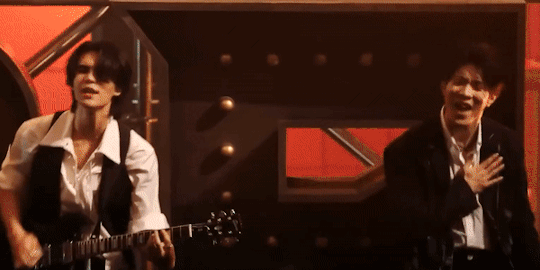

Call Me by Fire is a mainland Chinese TV competition show. They invite 33 established male celebrities with the goal to form an ultimate "boy band" by the show's conclusion. What tends to be the incredible pulling factor is they'll invite a combination of singers, musicians, actors, dancers, idols, presenters - incredibly well known faces in the industry - many of them hugely respected OGs in their field. (The demographic is usually late 20s+) so there's an intentional sense of maturity, experience and wisdom amongst the ensemble. The emphasis isn't really on forming this 'fictional' boy band, it acts as a mechanism for us to get more up close and personal with these artists. Allowing viewers to appreciate their creative genius, as well as who they are as people.
This show came as a spin off of another series 'Sisters Who Make Waves' which has the exact same premise but for female celebrities. Because it became such an instant hit, they made a male version shortly after.

As a Chinese speaker, I've been watching both shows since they started in 2020. Both are in their third season (with Call Me by Fire broadcasting right now). This year they've decided to include more participants (of mainly Chinese/Asian descent) from America, Korea, Japan, Vietnam and Thailand - along with the majority from China, Hong Kong and Taiwan.
Why I find this show both incredibly entertaining and compelling is because you get to watch spectacular collaborations between some of the most talented artists of this generation, and witness them embark on a journey of brotherhood through a shared love for performance (they live, work and perform together for the duration of the show). For me, theres also a massive nostalgia factor, because a large portion of these artists will be people I grew up watching.
There will be a lot of new attention on this show due to the Jeff's involvement (whose dubbed ‘Luo Jie Fu’ in Chinese). We’re only on Episode 2, and he's already making a huge impression, earning one of two MVPs spots after their first live performance - his group ranking 2nd out of 8, and his personal ranking being 7th overall (based on the live audience popularity vote).
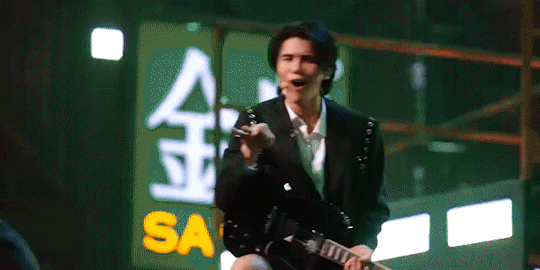

The show is uploaded onto Youtube in full (post-broadcast on a Saturday). Just to warn you, the episodes are usually very, very long (sometimes between 2-3 hours in total), but I personally really enjoy that. There are English subtitles but the translations don’t always capture the nuances.
Jeff is doing a superb job so far and he's very brave for taking this on. He brings something distinctly unique in his showmanship and personal sense of style. It's a daunting prospect for someone who can't speak or understand Chinese, but the other brothers are doing their best to help him feel as welcome and settled in as possible.
If anyone has any questions about the show or clips featuring Jeff they'd like to know more about, I'm more than happy to translate.
#call me by fire#call me by fire s3#jeff satur#chinese tv#how much charisma does jeff have?#YES#yes to everything basically#the boy was born to perform
136 notes
·
View notes
Text
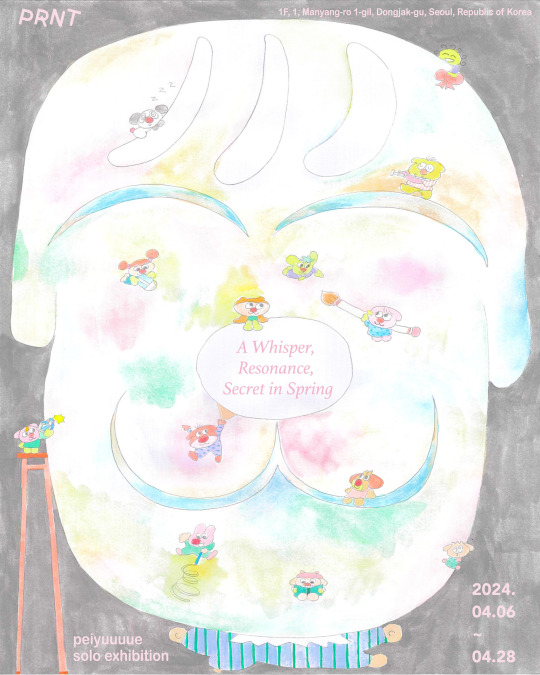
Finally announced!!!! I'm so excited~~~~!!!!
"A whisper, resonance , secret in spring" my new solo exhibition is in Seoul since next week! Please share it for me to your friends!I will be there at the opening for book sign and easy talk! This is a whole new exhibition with new love.
See you soon! Our Seoul soul friends!
[Exhibition Introduction]
This exhibition features the artist Peiyuuue, who is actively showcasing her works not only in Taiwan but also in Korea. The character 'Happy,' which appears prominently in the artist's works, may seem simple and innocent like a child's drawing at first glance, but it is actually the artist's closest friend and alter ego, supporting and encouraging her to overcome dark and difficult times. As a result, when looking at Peiyuuue's artwork, it feels as if the inner child within oneself is being comforted by a warm embrace. With the arrival of the gentle spring, may we encounter the 'Happy' within our hearts along with Peiyuuue's exhibition.
[Artist's Message]
Let's bask in the sunshine and fall in love with our shining self.
The theme of this exhibition is consisting of three series of works.
A whisper is a little secret told to you when someone whispers your name, a simple story started by self-talk. No matter what you like to do or what you are looking for, although there may not be an answer, the process is the scenery.
Resonance lives up to its name, simple joy in its purest form. Small mosaics spell out your favorite happy moments this year. Having these joys gives breathing space in a busy life. Only when such happiness is constructed in life will we know that happiness is simple.
Secret in spring is a series of paradises constructed under the artistic conception of spring. My world view is peace, contentment and joy.
If this is a world with only Happy, come in and take a look inside.
[Exhibition Event]
(1) PEIYUUUUE Exhibition Opening Event
Join us for the exhibition's opening event on Saturday, April 6th, on the PRNT 4th floor rooftop. From 3 PM to 5 PM, there will be an artist signing session, along with light refreshments.
*The reservation link will be released soon.
*Event schedule subject to change due to rain.
(2) PEIYUUUUE New Book and Merchandise Sale
(3) PEIYUUUUE x PRNT Collaborative Sticker Sale
[Exhibition Period]
April 6th (Sat) - April 28th (Sun), 2024
[Opening Hours]
Thu-Sun 2:00 pm - 6:00 pm
*Closed every Mon-Wed and on public holidays
[Exhibition Venue]
Manyang-ro 1-gil, Dongjak-gu, Seoul, PRNT 2F
27 notes
·
View notes
Text
Introduction
My first and foremost intention is to share Asian adaptations/translations/retellings of Les Misérables.
Call me Hadley.
I tag the country and the language of the adaptation or translation, and from there you can navigate.
Unfortunately much of my resources are Japanese, so there will be a bias on that in terms of Asian content. Bear with me please ㅜㅜ
If you need information on where to find these adaptations, I can provide them.
Please have a good time scrolling through my account. I encourage interactions and questions.
Please, do not joke about suicide in relation to you or me on my blog. It sounds very specific but, hey, it happens. Until this statement gets deleted, please respect this request.
I also have an account about Ainu resources: @hawon-ee
-------
Submit suggestion of Asian adaptation to explore:
-------
Click below for adaptations discussed.
China
Chinese fandom (and modern translations)
Les Misérables Peking Opera | 京剧 悲惨世界
2023 Mandarin Les Misérables play|悲惨世界
1903 Su Manshu's translation
孤星淚(雨果)| gū xīng lèi
Hong Kong
《孤星淚》 中英劇團 | 2013 Hong Kong performance
Les Misérables manga classics
孤星淚(經典話劇版)| 2016 performance in Hong Kong
India
బీదలపాట్లు | Beedala Patlu
ஏழை படும் பாடு | Ezhai Padum Padu
कुंदन | Kundan
Indonesia
Vocal performances
Iran
2019 Tehran Musical production
Japan
青い鳥文庫|Aotoribunnko (book, two editions)
犬木加奈子|アロエッテの歌|Inuki Kanako|Alouette no uta
新井隆広|Arai Takahiro
Arm Joe
ルールブルーの友らへ | Dear Friends of L'Heure Bleu
五島夕夏|Gotou Yuuka's animal picture book
Japanese musical productions
ジャン・バルジャンとジャベール | Jean Valjean and Javert Audiobook
ジャンバルジャン物語|Jean Valjean monogatari
巨人傳|Kyojinndenn
Les Misérables 惨めなる人々 | Les Misérables mijime naru hitobito
まんが世界昔ばなし|Manga sekai mukashi banashi
みなもと太郎|Minamoto Tarou|Minamoto's manga
谷桃子バレエ団|Momoko Tani Ballet production
岡田純子|Okada Jyunko|Les Mis erotica
終わりなき旅路|Owarinaki tabiji
ポプラ世界名作童話|Popular sekai meisaku douwa (book)
レ・ミゼラブル 少女コゼット|Shoujo Cosette
少年少女世界名作の森|Shounenn shoujo sekai meisaku no mori (book)
TEAMバンミカス|Team Banmikasu manga
Korea
저학년을 위한 레 미제라블|Les Misérables for lower age students (Athena Publishing)
Korean Musical productions
쟌발쟌 (1961) | 1961 Korean Movie
도둑 (1996) | 1996 Korean TV series
레미제라블 창작뮤지컬|Original musical soundtrack
삼성당|Samseongdang The Classic Les Misérables
University performances
세계문학그림책|World Cultures Picture Book
Lebanon
Arab Idol and other vocal performances
Les Misérables 1974 series | دراما البؤساء
Mongolia
Musical performances
Philippines
Manila 2016
Singapore
Singapore's 2016 musical production
Sri Lanka
දුප්පතාගේ දුක|Duppathage Duka
Taiwan
University performances
Thailand
A Wish in the Dark
Türkiye
Sefiller
Vietnam
Hồ Biểu Chánh | Ngọn Cỏ Gió Đùa (1926 novel)
Ngọn Cỏ Gió Đùa (1989 Movie)
Ngọn Cỏ Gió Đùa (2013 TV series)
Nguyễn Văn Vĩnh's 1926 translation
12 notes
·
View notes
Text
The Sounds of Taiwanese
I'm back to posting about Taiwanese after... we don't have to say how long haha. In this post I'm going to break down the vowels and consonants of Taiwanese! We'll save the tones for later because I think they deserve a post of their own. Transcriptions in this post are in the Tâi-lô romanization system.
Taiwanese Initial Consonants

The four main places of articulation used in Taiwanese are bilabial, alveolar, velar, and glottal. These correspond to the places of articulation used for the English/Mandarin pinyin letters p, t, k, and h.
The nasal consonants in Taiwanese are similar to their English/Mandarin counterparts, except that ng can appear at the beginning of syllables, as in the word 扭 ngiú "to twist". To practice this sound, say a word like "singing", then take off the si-.
Taiwanese distinguishes three types of stop and affricate consonants: voiced unaspirated, voiceless unaspirated, and voiceless aspirated. The latter two are about the same as b and p in Mandarin, which lacks fully voiced consonants. Most English speakers (to my knowledge) don't produce fully voiced stop consonants either, so this distinction can take some practice and listening.
Taiwanese aspirates are alveolar in most contexts, meaning they are pronounced like the ts in a word like "cats", but alveolo-palatal when they come before the vowel -i, meaning they are closer to a Mandarin q/j/x or English ch sound.
Taiwanese l can vary between an l sound and a tapped r, like the r in Spanish or Japanese.
Taiwanese Vowels

Taiwanese's six vowel system is actually pretty straightforward compared to Mandarin's. i, e, a, and u are pronounced similarly to Spanish (as opposed to English, in which we like to make our vowels into diphthongs). oo is like a Spanish o, produced with the mouth slightly more open.
o is pronounced like a Spanish o in Northern Taiwan and a schwa (the vowel in English "but") in Southern Taiwan.
Taiwanese has a diphthongs (combinations of two vowels) and triphthongs (combinations of three vowels). They are: ai, au, ia, iau, io, iu, ua, uai, ue, and ui.
Taiwanese also has syllabic nasals! The consonants m and ng can appear as the final of a syllable without a vowel, as in the words 毋 m̄ "not" and 遠 hn̄g "far".
Taiwanese also also has nasalized vowels, as in French "non". Most vowels and diphthongs can be nasalized, but not all. In Tâi-lô, a nasalized vowel is represented with two n's, as in ann or iunn.
Taiwanese Final Consonants

Taiwanese syllables can not only end in -n and -ng, like in Mandarin, but also -m.
Taiwanese syllables can also end in stop consonants! These consonants are generally not released. This is similar to the how final consonants of the English words "stop", "cat", and "back" are commonly pronounced.
The glottal stop doesn't so much have a sound of its own, but it makes the preceding vowel sound short and cut off. The sound in the middle of the English word "uh-oh" is a glottal stop.
Final Notes
There are rules governing the ways that these initials, vowels, and final consonants can be combined, but I don't think memorizing them is that useful to a beginning learner.
I've provided IPA and the best explanations I could come up with, but if you want to learn to pronounce Taiwanese the best thing to do is listen! Most resources come with audio, as does the dictionary https://sutian.moe.edu.tw/.
The sources I used for this post include Taiwanese Grammar: A Concise Reference by Philip T. Lin, Short Takes: A Scene-Based Taiwanese Vocabulary Builder by Pin-chih Chi, Southern Hokkien: An Introduction by Bernhard Fuehrer and Yang Hsiu-Fang, and the Wikipedia page for Taiwanese Hokkien.
16 notes
·
View notes
Text
[OPEN ACCESS] “How Taiwan Became Chinese: Dutch, Spanish, and Han Colonization in the Seventeenth Century” by Tonio Andrade
Table of Contents
Acknowledgments Preface Reader's Guide Introduction 1. Taiwan on the Eve of Colonization 2. A Scramble for Influence 3. Pax Hollandica 4. La Isla Hermosa: The Rise of the Spanish Colony in Northern Taiwan 5. The Fall of Spanish Taiwan 6. The Birth of Co-Colonization 7. The Challenges of a Chinese Frontier 8. "The Only Bees on Formosa That Give Honey" 9. Lord and Vassal: Company Rule over the Aborigines 10. The Beginning of the End 11. The Fall of Dutch Taiwan Conclusion
40 notes
·
View notes
Text
Summertime adventure game Once Again now available for Switch - Gematsu

AMATA K.K. has released a Switch version of RB Wolf Games-developed adventure game Once Again via Nintendo eShop for $5.99, the publisher announced.
Once Again first launched for PC via Steam, iOS via App Store, and Android via Google Play on October 3, 2022.
While not officially announced by AMATA K.K., PlayStation 5, Xbox Series, PlayStation 4, and Xbox One versions of Once Again were also recently rated in Taiwan, suggesting their release is coming soon.
Here is an overview of the game, via its store pages:
About
Make up for lost time with Once Again, this summer’s most heartwarming indie game. If you could travel through time, who’s the first person you’d meet? When teenage boy Sia opens his eyes after making a wish on a boring summertime birthday, he finds himself in an unfamiliar time, in front of a familiar someone who he never had the chance to meet. Together, she and Sia will form a bond through photography, while recapturing their lost time into rolls upon rolls of film. Who is she, and what journey awaits this star-crossed duo? Is a goodbye an ending, or a promise for a reunion? Let’s find the answers together, across time and space, in Once Again.
Key Features
Every birthday, Sia gets to make up for a lifetime of missed moments with her.
Transcending time and space, Sia’s bond with her is poised to be summer’s most heartwarming tale.
Immersive interactive gameplay lets you directly control Sia’s actions with charmingly simple, yet satisfying gameplay mechanics such as scrubbing, writing, taking photos and more.
Stunning illustrated art style that weaves the narrative and gameplay into a wistful, nostalgic journey.
Photography-inspired gameplay mechanics such as focus, exposure and more serve as the perfect introduction to a timeless art form.
For Once Again, WeiFan has weaved together a gorgeous lineup of tracks that truly express all the feelings and thoughts that just can’t be put into words, and we can’t wait for you to experience them in our story!
Watch a new trailer below.
Switch Launch Trailer
English
youtube
Japanese
youtube
6 notes
·
View notes